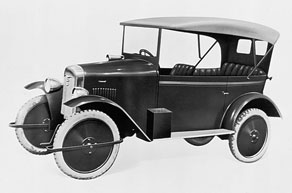 |
Jitsuyo Jidosha Co., Ltd. and the Lila

There were some extraordinary pioneers in the infancy of the automobile age who laid the foundations for the development of the industry. In 1919-20, an American called William R. Gorham succeeded in developing a 3-wheeled car. This excited the imagination of some Osaka entrepreneurs (including the President of Kubota, Ltd.), who set up the Jitsuyo Jidosha Co., Ltd. in order to turn it into a commercial reality. From then until 1926, when it became the Dat Jidosha Seizo Co., this company produced about 100 Gorham 3-wheel and 4-wheel cars, and about 200 Lila automobiles.
The Lila, which appeared in 1923, was a 4-wheel vehicle with seating for 4, designed as a practical means of transport given the state of Japan’s roads at that time. It greatly influenced the design concept of the later Datsun. The Lila’s 1,260cc engine had 2 cylinders in a V configuration and was rated at 8.4 horsepower (maximum output was 10hp). It was available in a wide range of models: Type A sedan, convertible, roadster and truck. The purple color of the sedan’s bodywork proved to be very popular at the time. The name "Lila" came from lilac, a plant with purple blossoms. The roadster was a two-seater, but the trunk featured a rumble seat for an extra passenger behind; it was sporty too, boasting a top speed of 56km/h.
The Jitsuyo Jidosha Co., Ltd. was later subject to government (military) control, and in 1926 it merged with the DAT Jidousha Shokai Company in Tokyo. William R. Gorham, who took Japanese citizenship, continued to work on development for the new company, and eventually served on the Board of Directors at Nissan.
|
 |



The Lila, created by the Jitsuyo Jidosha Co., Ltd. in 1923, was together with the DAT to lay the foundation for Nissan car development. Named after the purple lilac, it carried four people and with its 6kW (8.4PS) engine had a maximum speed of 56km/h. (Photo shows later model.) |
